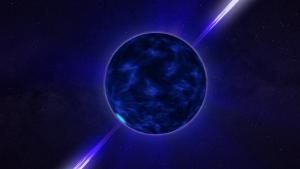Blog
A Dark Light
23 June 2023
 NASA’s Goddard Space Flight Center Conceptual Image Lab
NASA’s Goddard Space Flight Center Conceptual Image LabThe first stars of the universe were very different than the stars we see today. They were made purely of hydrogen and helium, without heavier elements to help them generate energy in their core. As a result, they were likely hundreds of times more massive than the Sun. But some of the first stars may have been even stranger. In the early universe, dark matter could have been more concentrated than it is now, and it may have powered strange stellar objects known as dark stars.
Since dark matter and regular matter act similarly under gravity, clumps of dark matter in the early universe could have gathered clouds of hydrogen and helium around them. As this matter collapsed under its own weight, dark matter in its core might have generated energy. In some dark matter models, the particles can annihilate to produce gamma rays and neutrinos. These high-energy particles would prevent the cloud from collapsing, similar to the way nuclear fusion sustains a regular star.
These dark stars would have been gigantic, with a diameter tens of thousands, even hundreds of thousands of times wider than the Sun. But they would have been dim and fairly low-density. If they existed, they would have been too faint and distant for current telescopes to detect them. But the Nancy Grace Roman space telescope, formerly called WFIRST, might be powerful enough to find them.1
 University of Utah
University of UtahThe Roman telescope is scheduled to be launched in May 2027. It will be a wide-field infrared telescope, well suited to explore the dim and distant edge of the cosmos. According to a recent paper published on the arxiv, Roman might be able to observe supermassive dark stars with masses greater than 100,000 Suns. But dark stars on this scale weren’t likely common. A better estimate is that dark stars were around 10,000 solar masses. With the help of gravitational lensing, Roman might be able to see a dark star of that mass, but the authors propose a better method, combining observations of Roman with the James Webb Space Telescope.
Their idea is to identify dark star candidates using Roman, with the understanding that the photometric observations won’t be able to distinguish dark stars from small young galaxies. One feature that distinguishes the galaxies from dark stars is that the latter should show a helium emission line known as λ1640, which Webb can detect. Roman is better suited for finding candidates, and Webb can confirm them. It’s an excellent example of how the strengths of different telescopes can complement each other.
If this approach is successful in the next decade, it could help astronomers understand a different cosmological mystery, that of supermassive black holes. We still don’t understand how such massive black holes could form so quickly in the early universe, but one idea is that they may have been seeded by these dark stars. As their dark matter cores stopped generating energy, these stars may have collapsed quickly enough to form a massive black hole, which could grow into a supermassive black hole in time.
There’s much we could learn from the dim light of a dark star.
Zhang, Saiyang, Cosmin Ilie, and Katherine Freese. “Detectability of Supermassive Dark Stars with the Roman Space Telescope.” arXiv preprint arXiv:2306.11606 (2023). ↩︎